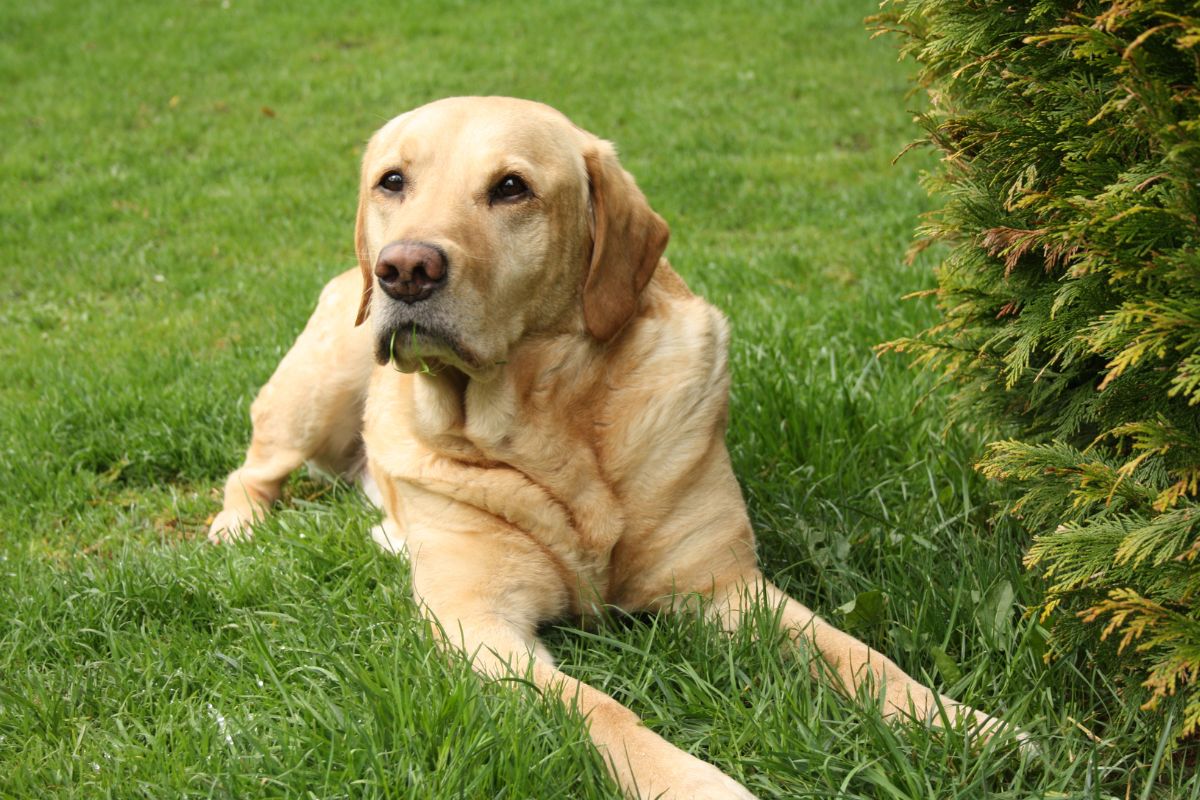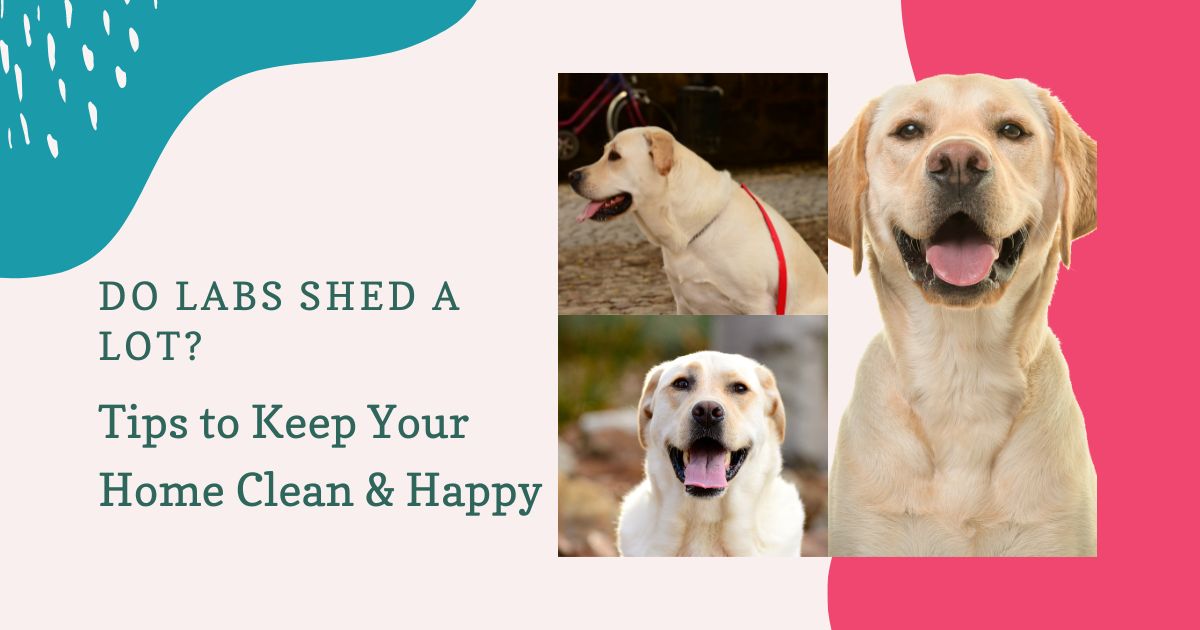Welcome to our discussion on Labrador Retrievers, often called “labs.” If you’re considering adding one to your household, you may wonder, “Do labs shed a lot?”
Labs indeed shed consistently throughout the year, with two major shedding seasons. Despite this, they’re known for their loyal, gentle nature, which often outweighs any hair-related concerns.
Learn more about this breed and tips for managing their shedding in our comprehensive guide.

Do Labs Shed a Lot?
Certainly, Labradors are notorious for their substantial shedding. This characteristic, often called “labrador shedding,” is primarily due to their double coat: a dense undercoat and a water-resistant top coat.
Consequently, Labs regularly lose a high hair volume, which can seem relentless to their owners. However, each Lab is unique, and shedding varies from dog to dog. Yet, Labrador shedding remains a natural and expected part of owning such a lovable breed.
How Much Do Labs Shed?
Lab shedding is indeed substantial and most pronounced during the spring and autumn. These periods are commonly known as the Labrador “shedding season.”
In the spring, Labs shed their heavy winter coat to prepare for the warmer months, and in the autumn, they lose their lighter summer coat to make way for a denser coat for the colder months. This cyclical shedding, characteristic of Labrador shedding season, is part of their adaptation to changing weather conditions.
Does the Coat Color Affect Labrador Shedding?
The perception of shedding can sometimes be influenced by a Labrador’s coat color. For instance, do black Labs shed a lot? How about chocolate Labs or yellow Labs?
In reality, all Labs shed considerably, but the visibility of their hair on various backgrounds can create differing perceptions. Shedding in Labs with lighter hair, like yellow Labs, may appear more noticeable against dark upholstery, carpets, and clothes.
Other factors influencing shedding include the female heat cycle and living in hotter climates. It’s important to remember that while coat color may affect the visibility of shed hair, all Labs – black, chocolate, and yellow – are infamous shedders!
Our Labrador Shedding Solutions
When it comes to our Labrador shedding solutions, the solution lies in a holistic approach that involves grooming, dietary, and lifestyle changes. Regular brushing is key to managing Labrador shedding, especially during heavy shedding seasons.
For this, deshedding tools and brushes explicitly designed for double-coated dogs, like Labs, can be instrumental. Using lukewarm water during baths and incorporating a gentle massage can also help remove excess hair.
It’s important to note that shaving a Lab to reduce shedding is not recommended. This approach can lead to skin problems and doesn’t effectively reduce shedding. Instead, consider restricting where dog hair ends up. Keeping Labradors out of certain rooms or using seat covers in the car can be effective strategies. Smart vacuums, designed specifically for pet hair, can also be an effective addition to your home, aiding in managing loose hair.
Proper hydration and a balanced, high-quality diet are vital in minimizing shedding. The health of a Lab’s coat, and consequently, the amount they shed, is directly influenced by their nutritional intake.
Also, calling in a professional groomer occasionally can offer additional help with Labrador grooming and shedding. While these techniques require consistent effort, they can significantly alleviate the challenges of Labrador shedding.

Do Labs Have a Double Coat?
Indeed, Labradors possess a distinctive double coat. This coat consists of two layers: a dense undercoat and a protective topcoat.
The undercoat provides insulation, helping to regulate the body temperature of the Lab in various weather conditions.
The topcoat, on the other hand, is water-resistant and helps keep the coat clean by repelling dirt and debris. This double coat contributes significantly to labrador shedding, making it a crucial factor to consider if you’re thinking about bringing a Lab into your home.
When Do Labs Shed the Most?
Labs shed the most during two primary periods, often referred to as the labrador shedding season: once in the spring between March and May and also in the fall between October and December.
During these molting seasons, which typically last about two to three weeks, Labs shed their old coats to make way for new ones more suited to the changing weather. Although these are peak shedding periods, Labradors do shed year-round.
Understanding the labrador shedding season is key for potential and current Labrador owners to help manage this breed’s abundant shedding.
Why Do Dogs Shed a Lot of Hair?
Dogs, including Labs, naturally shed their hair as a way of removing old or damaged hair, thus promoting healthy skin. However, if you’re asking, “Why does my lab shed so much?” and noticing excess shedding, various factors could be contributing.
These can range from dietary issues and using inappropriate shampoo to more complex causes like stress, skin parasites, or even hormone imbalances.
More severe conditions could also trigger heightened shedding, suggesting a possible need for veterinary consultation. Identifying these potential causes is crucial to effectively managing and possibly reducing your Lab’s shedding.
Do Labradors Shed More Than Other Breeds?
Yes, Labradors tend to shed more than certain dog breeds, primarily due to their double coat. However, they’re not alone in their shedding habits. They’re on par with other double-coated breeds when it comes to shedding. Here are some other dog breeds that are also known for significant shedding:
- German Shepherds
- Golden Retrievers
- Huskies
- Malamutes
- Australian Shepherds
It’s important to remember that shedding is natural, although the extent can vary widely across breeds. If you’re considering a Labrador, understanding their shedding habits can help you better prepare for this aspect of their care.
Does Shedding Imply a Sick Dog?
While it’s normal for dogs like Labradors to shed, excessive shedding can sometimes be a red flag for underlying health issues. If you notice an unusual increase in shedding, it’s essential to consult a vet to rule out potential health problems.
Modifications in grooming practices, diet, or lifestyle can often be part of effective labrador shedding solutions. But remember, while shedding can be a symptom of illness, it’s also a natural part of a dog’s life, especially for breeds like Labradors with their characteristic double coats.
Excessive shedding in Labrador breeds can sometimes be a sign of various health issues. Here are a few potential conditions:
Skin Conditions
Various skin issues, including parasites (fleas, ticks, mites), allergies, dermatitis, or fungal infections, can lead to excessive shedding. These conditions may also cause noticeable discomfort, like itching or skin redness.
Poor Nutrition
An imbalanced or low-quality diet might not supply the necessary nutrients for a healthy coat, leading to increased shedding. Certain nutrient deficiencies, particularly in Omega-3 and Omega-6 fatty acids, can result in a dry, brittle coat that sheds more than usual.
Stress or Anxiety
Just like in humans, stress or anxiety can lead to physical symptoms in dogs, including increased shedding. Changes in the home environment, separation anxiety, or consistent loud noises are just a few examples of stressors that could affect your Lab.
Hormonal Imbalances
Conditions like hypothyroidism can lead to hair loss in dogs. Hormonal changes related to the heat cycle in unspayed females can also increase shedding.
Underlying Illnesses
Certain systemic diseases, like liver disease, kidney disease, or cancer, can cause excessive shedding, among other symptoms.
If you observe excessive shedding in your Labrador, it’s essential to consult with a veterinarian. They can help highlight the underlying cause and provide appropriate treatment options.

Conclusion
In summary, Labrador Retrievers are notorious for their shedding. Whether it’s black Labs, chocolate Labs, or yellow Labs, all do shed a lot.
This shedding occurs year-round, with the most intense periods known as the labrador shedding season, during spring and fall. The double coat of Labs, consisting of an undercoat and a topcoat, contributes significantly to this shedding phenomenon.
The question “Why does my Lab shed so much?” is often raised by Labrador owners. While shedding is a natural process integral to the dog’s overall health, excessive shedding could indicate underlying health conditions. Hence, it’s advisable to consult a vet if your Lab’s hair loss seems absurd.
When managing the abundant Labrador shedding, several solutions can be implemented. Regular brushing using appropriate deshedding tools, ensuring a nutritious diet, and maintaining proper hydration can all help mitigate shedding.
Although you might wonder about shaving a Lab to reduce shedding, it’s generally not recommended as it can potentially cause skin problems and doesn’t effectively reduce shedding.
In essence, if you’re considering bringing a Labrador into your life, it’s essential to understand and prepare for their shedding habits. With appropriate care, the question “How much do Labs shed” becomes less daunting as you equip yourself with effective labrador shedding solutions.
Why not combat shedding in Labrador breeds by purchasing a deshedding tool listed in our article about 14 Brushes for Double-Coated Dogs?
Happy De-Shedding!

